The NVIDIA GeForce GTX 980 Ti Review
by Ryan Smith on May 31, 2015 6:00 PM ESTCompute
Shifting gears, we have our look at compute performance. Since GTX Titan X has no compute feature advantage - no fast double precision support like what's found in the Kepler generation Titans - the performance difference between the GTX Titan X and GTX 980 Ti should be very straightforward.
Starting us off for our look at compute is LuxMark3.0, the latest version of the official benchmark of LuxRender 2.0. LuxRender’s GPU-accelerated rendering mode is an OpenCL based ray tracer that forms a part of the larger LuxRender suite. Ray tracing has become a stronghold for GPUs in recent years as ray tracing maps well to GPU pipelines, allowing artists to render scenes much more quickly than with CPUs alone.
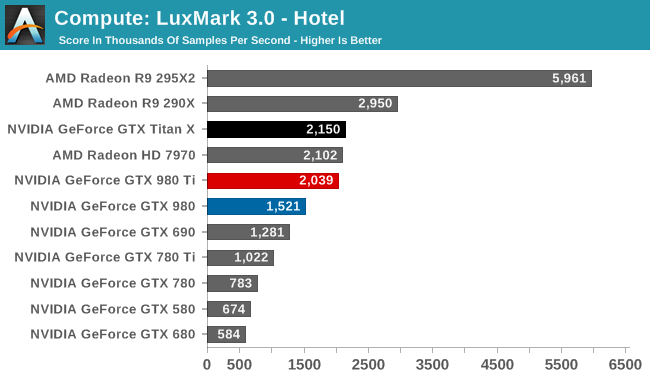
With the pace set for GM200 by GTX Titan X, there’s little to say here that hasn’t already been said. Maxwell does not fare well in LuxMark, and while GTX 980 Ti continues to stick very close to GTX Titan X, it none the less ends up right behind the Radeon HD 7970 in this benchmark.
For our second set of compute benchmarks we have CompuBench 1.5, the successor to CLBenchmark. CompuBench offers a wide array of different practical compute workloads, and we’ve decided to focus on face detection, optical flow modeling, and particle simulations.
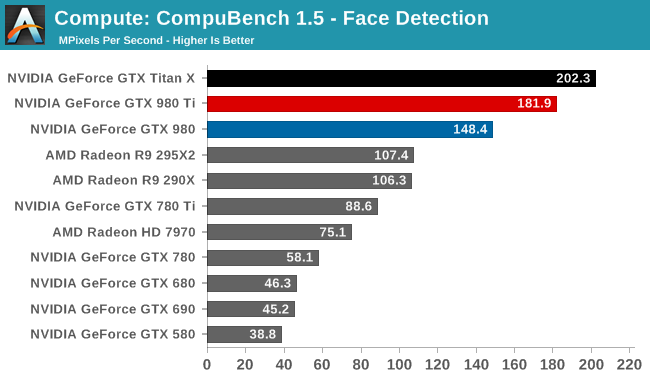
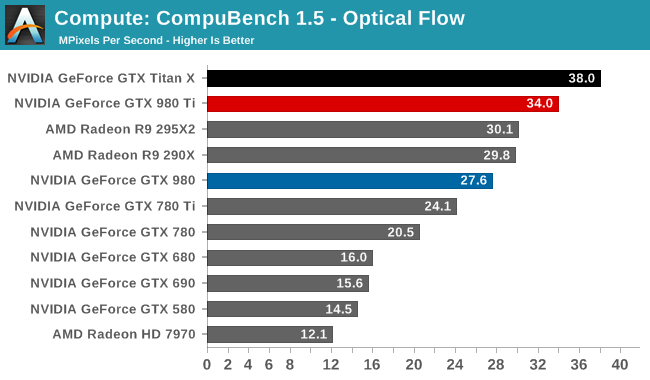
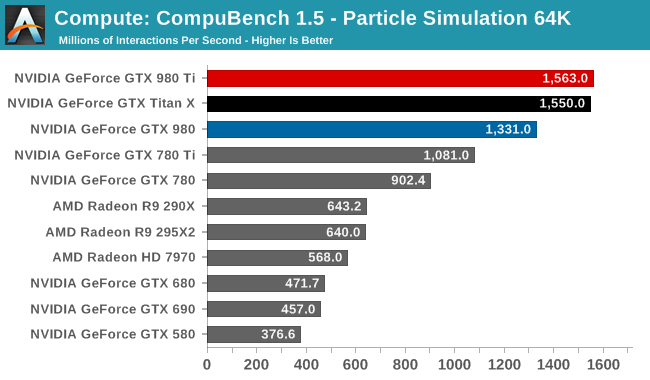
Although GTX T980 Ti struggled at LuxMark, the same cannot be said for CompuBench. Though taking the second spot in all 3 sub-tests - right behind GTX Titan X - there's a bit wider of a gap than normal between the two GM200 cards, causing GTX 980 Ti to trail a little more significantly than in other tests. Given the short nature of these tests, GTX 980 Ti doesn't get to enjoy its usual clockspeed advantage, making this one of the only benchmarks where the theoretical 9% performance difference between the cards becomes a reality.
Our 3rd compute benchmark is Sony Vegas Pro 13, an OpenGL and OpenCL video editing and authoring package. Vegas can use GPUs in a few different ways, the primary uses being to accelerate the video effects and compositing process itself, and in the video encoding step. With video encoding being increasingly offloaded to dedicated DSPs these days we’re focusing on the editing and compositing process, rendering to a low CPU overhead format (XDCAM EX). This specific test comes from Sony, and measures how long it takes to render a video.

Traditionally a benchmark that favors AMD, GTX 980 Ti fares as well as GTX Titan X, closing the gap some. But it's still not enough to surpass Radeon HD 7970, let alone Radeon R9 290X.
Moving on, our 4th compute benchmark is FAHBench, the official Folding @ Home benchmark. Folding @ Home is the popular Stanford-backed research and distributed computing initiative that has work distributed to millions of volunteer computers over the internet, each of which is responsible for a tiny slice of a protein folding simulation. FAHBench can test both single precision and double precision floating point performance, with single precision being the most useful metric for most consumer cards due to their low double precision performance. Each precision has two modes, explicit and implicit, the difference being whether water atoms are included in the simulation, which adds quite a bit of work and overhead. This is another OpenCL test, utilizing the OpenCL path for FAHCore 17.
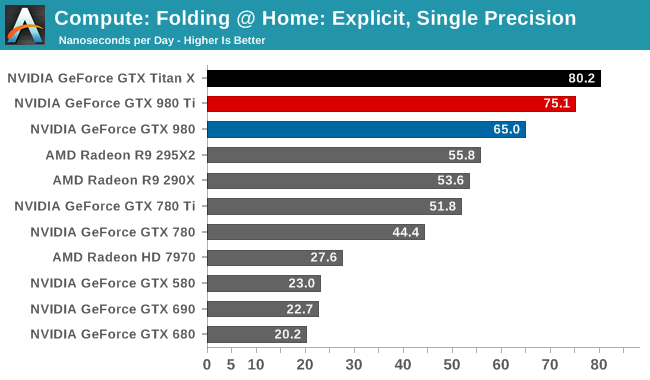
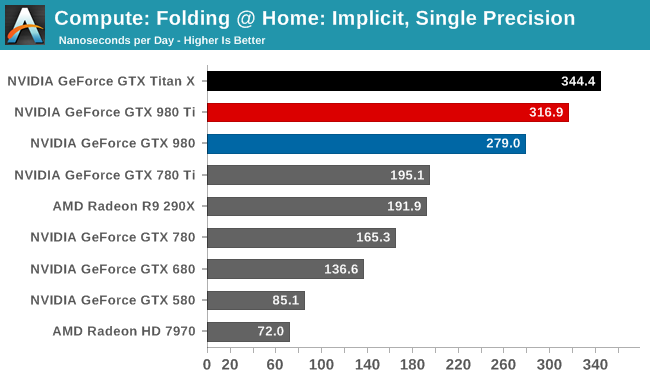
Folding @ Home’s single precision tests reiterate GM200's FP32 compute credentials. Second only to GTX Titan X, GTX 980 Ti fares very well here.
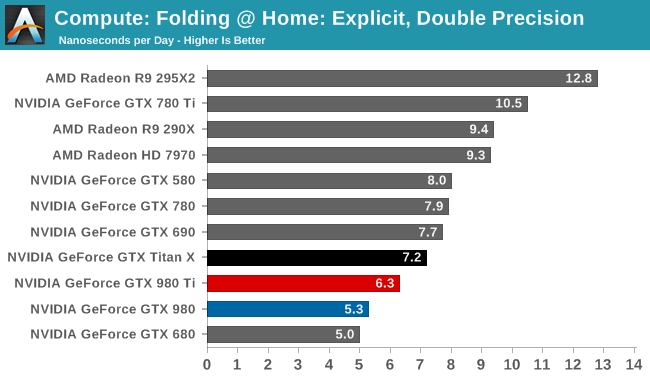
Meanwhile Folding @ Home’s double precision test reiterates GM200's poor FP64 compute performance. At 6.3ns/day, it, like the GTX Titan X, occupies the lower portion of our benchmark charts, below AMD's cards and NVIDIA's high-performnace FP64 cards.
Wrapping things up, our final compute benchmark is an in-house project developed by our very own Dr. Ian Cutress. SystemCompute is our first C++ AMP benchmark, utilizing Microsoft’s simple C++ extensions to allow the easy use of GPU computing in C++ programs. SystemCompute in turn is a collection of benchmarks for several different fundamental compute algorithms, with the final score represented in points. DirectCompute is the compute backend for C++ AMP on Windows, so this forms our other DirectCompute test.

We end up ending our benchmarks where we started: with the GTX 980 Ti slightly trailing the GTX Titan X, and with the two GM200 cards taking the top two spots overall. So as with GTX Titan X, GTX 980 Ti is a force to be reckoned with for FP32 compute, which for a pure consumer card should be a good match for consumer compute workloads.










290 Comments
View All Comments
Laststop311 - Monday, June 1, 2015 - link
The performance difference between the 980ti and 980 is WAY larger than the performance difference between the 980 and 970 yet the price gap is larger between the 980 and 970. The 980 was stupidly overpriced at 550 and is still overpriced at 500. It needs to be at the 420-430 mark.I would be upset if I just paid 550 for a GTX 980 and now for only 100 more I could basically have titan x performance.
chizow - Monday, June 1, 2015 - link
And what value do you place on the 9 months that 980 users have been enjoying that level of performance? Again, if you think the 970 is the better deal, it is there for you to buy at $300-330. The 980 was overpriced by maybe $50 at launch, but it still dropped the entire price and performance landscape at the time where 780Ti was still $650+, 290X was $550, 780 was $450 and 290 was $400. In that context, it wasn't so bad, was it?In reality, Nvidia has no reason to drop the 980 as there is no pressure at all from AMD. All these price cuts are self-induced as they are simply competing with themselves and pre-emptively firing a shot across the bow at $650 with 980Ti.
Oxford Guy - Monday, June 1, 2015 - link
"In reality, Nvidia has no reason to drop the 980 as there is no pressure at all from a card with 3.5 GB of VRAM that, in part, runs at 28 GB/s and has XOR contention."fify
chizow - Monday, June 1, 2015 - link
"In reality, Nvidia has no reason to drop pricing on the 980, as there is no point in threatening the golden calf that may have single-handedly killed AMD graphics, 3.5GB VRAM and all."FTFY ;)
http://store.steampowered.com/hwsurvey/videocard/
NVIDIA GeForce GTX 970 2.81%
AMD Radeon R9 200 Series 0.94%
Oxford Guy - Tuesday, June 2, 2015 - link
I hope you're being paid for all this nonsense.Michael Bay - Tuesday, June 2, 2015 - link
Oh the pain.chizow - Tuesday, June 2, 2015 - link
Is it nonsense? I hope you are being paid for posting 3.5GB nonsense?darkfalz - Tuesday, June 2, 2015 - link
I dunno. I can't really justify an upgrade from my 980 STRIX (which would then replace beloved 680 in my HTPC) - I was hoping for at least 40% improvement. Not really worth it for 20-30%. Better off getting another 980 and SLI it.darkfalz - Tuesday, June 2, 2015 - link
I'm not sure why they aren't offering Witcher III as well as Batman. Why would a 970 get you two games? Not a great incentive to buy.SeanJ76 - Tuesday, June 2, 2015 - link
Yeah this card barely surpasses my 770 Sli, and I mean BARELY! I think I'll pass and wait for another die.